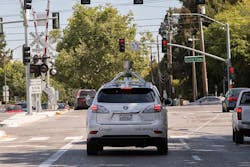In a Google blog post from Chris Urmson, director, Self-Driving Car Project, Google is slowly improving its laser-based, light detection and ranging (LIDAR)-based, radar-based, and other optoelectronic sensor-based self-driving automobiles to be better adapted to the complex demands of city streets rather than just freeways or highways.
RELATED ARTICLE: Lasers bring gesture recognition to the home
Urmson writes that Google self-driving cars have logged thousands of miles on the streets of their hometown of Mountain View, CA. A mile of city driving is much more complex than a mile of freeway driving, with hundreds of different objects moving according to different rules of the road in a small area. Google has improved its software so it can detect hundreds of distinct objects simultaneously: pedestrians, buses, a stop sign held up by a crossing guard, or a cyclist making gestures that indicate a possible turn. A self-driving vehicle can pay attention to the proximity of all of these things in a way that a human physically can't—and it never gets tired or distracted.
Jaywalking pedestrians, cars lurching out of hidden driveways, double-parked delivery trucks blocking your lane and your view—all challenges in a typical city street that can leave even experienced drivers sweaty-palmed and irritable. Urmson says that we all dream of a world in which city centers are freed of congestion from cars circling for parking and have fewer intersections made dangerous by distracted drivers, which is why over the last year Google has shifted the focus of the Google self-driving car project onto mastering city street driving.
As it turns out, what looks chaotic and random on a city street to the human eye is actually fairly predictable to a computer. By encountering thousands of different situations, Google says it has built software models of what to expect, from the likely (a car stopping at a red light) to the unlikely (blowing through it). They still have lots of problems to solve, including teaching the car to drive more streets in Mountain View before we tackle another town, but thousands of situations on city streets that would have stumped us two years ago can now be navigated autonomously.
Google vehicles have now logged nearly 700,000 autonomous miles, and with every passing mile Google says it is growing more optimistic that it's heading toward an achievable goal—a vehicle that operates fully without human intervention.
SOURCE: Google; http://googleblog.blogspot.com/2014/04/the-latest-chapter-for-self-driving-car.html

